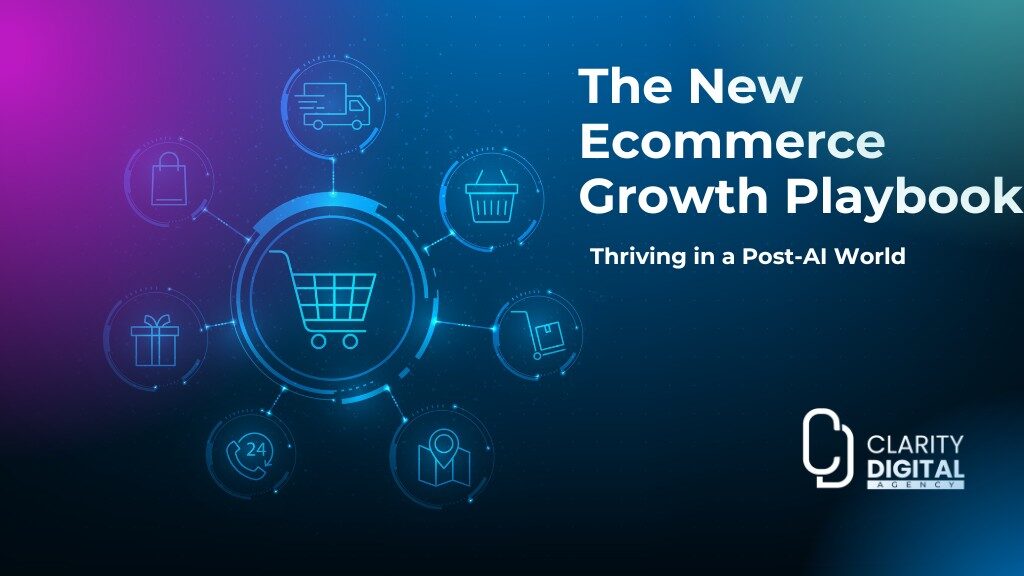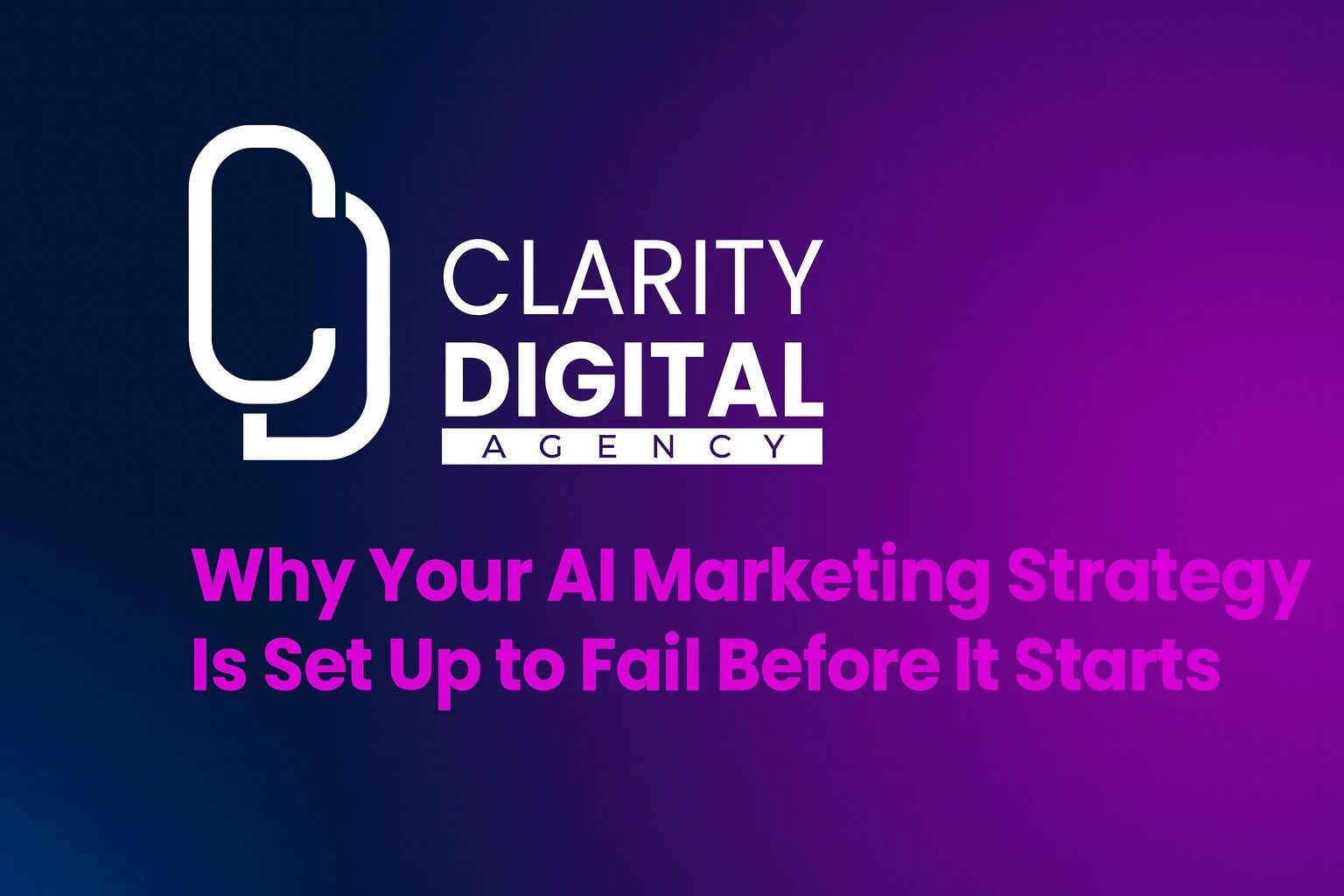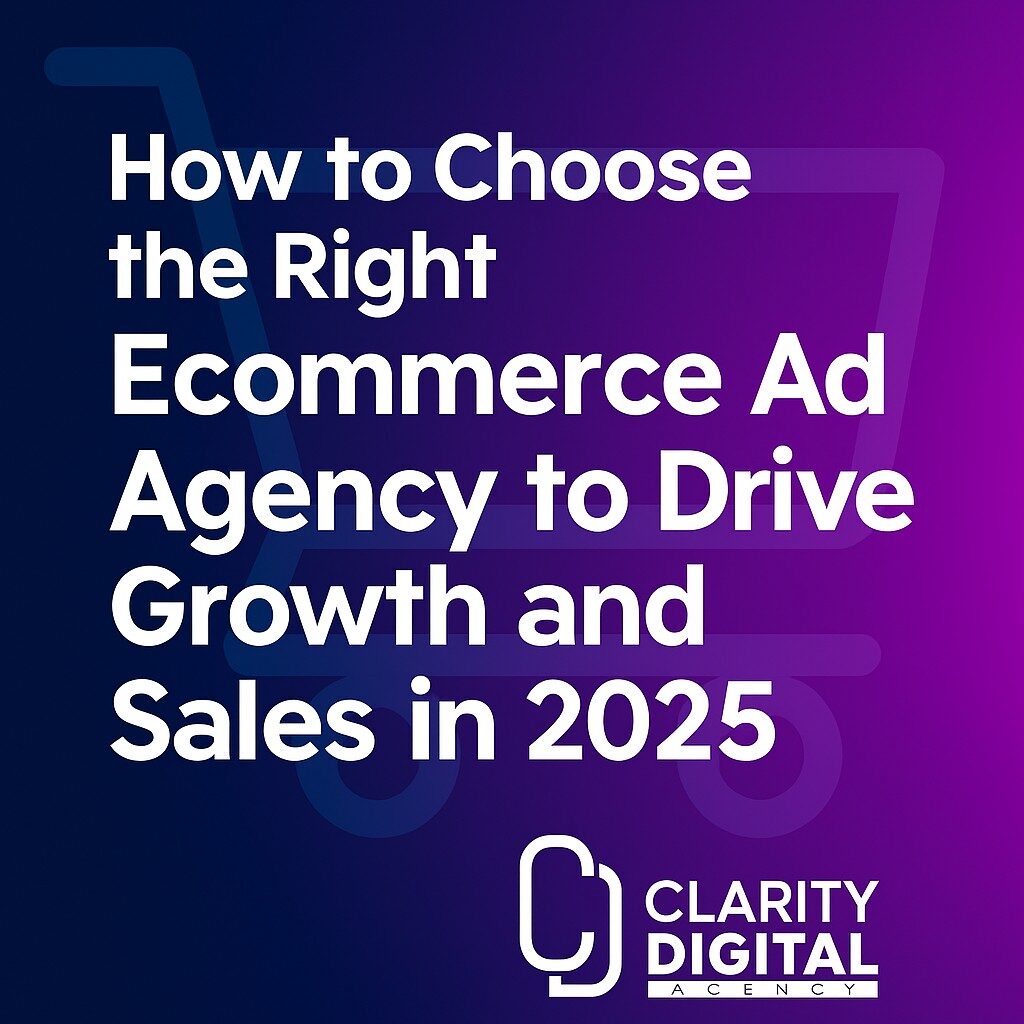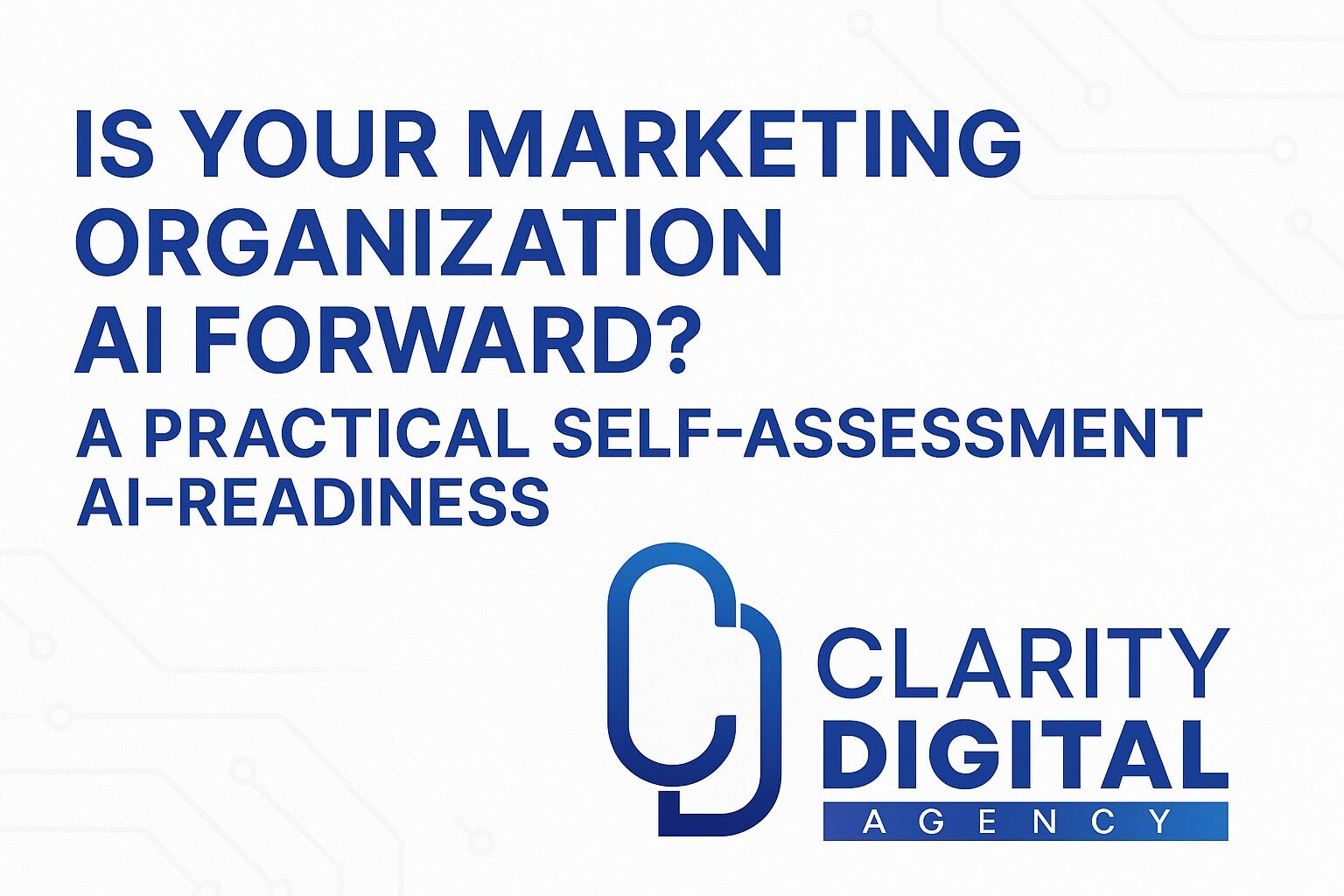Ecommerce marketing is no longer optional—it’s the backbone of digital growth in an AI-powered world. As of 2024, global ecommerce sales are expected to surpass $6.3 trillion (Statista), and the landscape is becoming smarter, faster, and more competitive. If you’re not leveraging AI-enhanced, data-driven marketing strategies, you’re not just falling behind—you’re losing visibility, efficiency, and market share.
Today’s ecommerce success isn’t just about running ads or ranking on Google. It’s about building a connected system of discovery, intent capture, personalized nurturing, and optimized conversions—driven by automation, real-time data, and intelligent tools. In this article, we’ll unpack what makes ecommerce marketing work today, how to reach and convert your ideal audience, and which channels and technologies to prioritize. We’ll also highlight the nuances between B2C and B2B ecommerce—and explain why Clarity Digital Agency is the trusted growth partner for AI-era brands.
Ecommerce Marketing in the Age of AI: What It Takes to Grow Smarter
Ecommerce marketing is no longer optional—it’s the engine behind digital growth in an AI-powered economy. In 2024, global ecommerce sales are expected to exceed $6.3 trillion (Statista), and brands that aren’t integrating AI into their marketing strategies risk falling behind. From predictive analytics to automated campaigns and real-time personalization, AI is reshaping how ecommerce brands attract, convert, and retain customers.
Winning in today’s ecommerce environment requires more than just running ads or chasing rankings. It’s about building an intelligent, interconnected system that captures intent, personalizes the journey, and drives conversions at scale—powered by data and automation. In this article, we’ll break down the core components of modern ecommerce marketing, how to target and convert with precision, and which AI-powered tools and channels deserve your focus. We’ll also explore the differences between B2C and B2B ecommerce strategies—and why brands across industries trust Clarity Digital Agency to drive growth in an AI-first world.
How to Identify and Reach Your Ecommerce Audience with Help of AI
ou can’t sell to someone you don’t understand—and in an AI-powered ecommerce world, understanding your audience goes far beyond basic demographics.
Start with demographics: Who are they? Age, location, income level, education.
Then add behavioral data: What pages do they visit? What do they click on? When do they buy?
Layer in psychographics: What are their values? What motivates their decisions? Are they price-conscious, brand-loyal, eco-conscious?
This is where AI makes the difference. Tools like GA4, Meta Audience Insights, and post-purchase surveys are a good starting point—but modern ecommerce brands go further by using AI-powered customer segmentation, predictive analytics, and lookalike modeling to surface patterns that humans often miss. Platforms like Klaviyo AI, Bloomreach, or Segment help you group audiences by likelihood to purchase, churn risk, or affinity for specific products.
You can also use AI heatmaps and behavioral analysis tools (like Microsoft Clarity or Hotjar with AI overlays) to see how different segments interact with your site in real time, then trigger dynamic content based on those behaviors.
From there, develop hyper-targeted campaigns using personalized email flows, AI-optimized social ads, tailored landing pages, and search intent-driven content—all continuously improved by machine learning algorithms that adapt with every click.
How to Analyze Competitors’ E-commerce Digital Strategies
You’re not just competing with Amazon—you’re competing with whoever your customers compare you to. Understanding your competitive landscape is essential, and AI now gives you deeper, faster, and smarter ways to analyze it.
Start by auditing competitors’ websites: Are they fast? Mobile-optimized? Do they use urgency or social proof? What is their value proposition?
Next, perform an SEO audit using tools like SEMrush, Ahrefs, or Surfer SEO, and enhance your findings with AI-based SEO tools like Outranking or Frase, which can use NLP to reverse-engineer top-ranking competitor content and suggest topic clusters or content gaps.
For social listening and engagement analysis, traditional tools like BuzzSumo and Brand24 are helpful—but now you can use AI tools like Sprinklr AI or Brandwatch AI to track sentiment, detect emerging trends, and identify which influencer collaborations or content types are driving the most conversions.
When reviewing ad strategies, use Meta Ad Library and Google Ads Transparency Center for visibility—but layer in AI tools like AdCreative.ai or Pattern89 to analyze patterns in ad creatives, predict top-performing formats, and even simulate competitor testing strategies.
These AI insights help you avoid guesswork and build smarter, more adaptive ecommerce strategies—rooted not just in what competitors are doing, but in what’s actually working and why.
What E-commerce Marketing Channels You Should Use—and How
To succeed in an AI-powered ecommerce environment, brands must combine proven marketing channels with intelligent automation and data-driven decision-making. Here’s how to prioritize and execute across the key channels—using both traditional approaches and AI-powered enhancements.
Drive Long-Term Organic Traffic with AI-Powered Ecommerce SEO (AIO)
SEO continues to deliver long-term value by attracting intent-driven traffic, but AI-powered SEO—often called AIO—takes it to the next level. Use platforms like Surfer, Clearscope, or Outranking to create optimized content based on SERP data. Incorporate keywords in titles, meta descriptions, and schema markup to improve visibility. AI tools like ChatGPT or Claude can generate long-tail FAQs, content briefs, and even help automate internal linking strategies. For technical SEO, leverage AI to flag performance issues, optimize site architecture, and dynamically generate metadata at scale.
Maximize ROI with AI-Optimized Ecommerce PPC Advertising
AI is transforming how ecommerce brands manage PPC campaigns. Platforms like Google Performance Max and Meta Advantage+ use machine learning to optimize bidding, placements, and creatives in real time. Tools like AdCreative.ai and Copy.ai can generate variations of ad copy and visuals to boost CTR. Predictive algorithms can also identify high-performing audience segments and allocate budget dynamically to maximize ROAS.
Boost Retention and Personalization with AI-Driven Email Marketing
Email remains one of the highest-ROI channels—but AI helps take personalization and efficiency to the next level. Use Klaviyo AI, RetentionX, or Drip to build automated flows that trigger based on behavior—like welcome series, cart recovery, and re-engagement. Predictive segmentation lets you group customers by likelihood to purchase, churn risk, or average order value. AI also determines the optimal send time for each user and can dynamically personalize content blocks within each email.
Scale Brand Awareness Using AI-Enhanced Social Media Advertising
Social media is essential for brand discovery, and AI helps brands stand out. Platforms like Modash and Upfluence use AI to identify creators aligned with your brand and predict campaign performance. AI-driven tools can analyze which creative formats, captions, and visuals drive the most engagement, and adjust posting times or ad formats accordingly. Meta and TikTok’s ad platforms now offer built-in AI optimization to improve targeting and conversion.
Leverage Affiliate and Influencer Marketing for Ecommerce Growth
Partnering with the right creators is more scalable with AI. Use tools like Affable.ai or Impact.com to find influencers based on engagement, audience fit, and forecasted ROI. AI can monitor influencer-generated content performance in real time and recommend which pieces to repurpose for paid campaigns, email, or landing pages.
Use AI to Supercharge SMS and Push Notifications for Higher Conversions
These immediate channels are ideal for limited-time offers, and AI can make them even more effective. Postscript and Attentive offer AI features that optimize timing and message variation. AI can test multiple versions of messages—such as discount offers versus reminders—and automatically promote the version that converts best.
When used together, these channels create a marketing flywheel. AI-enhanced email nurtures interest generated by SEO and paid ads. Predictive social ads re-engage previous visitors. AIO strategies keep your site ranking organically. In an AI-first ecommerce world, success isn’t about managing more channels—it’s about making every channel smarter and more connected.
B2C vs. B2B E-commerce Marketing Strategy: What’s the Difference?
While B2C and B2B e-commerce share the goal of driving online revenue, the strategies and tactics often differ significantly.
How to Build a High-Converting B2C Ecommerce Marketing Strategy
Below are key elements and differentiators in a B2C eCommerce marketing campaign
- Emotional engagement is key. Use visuals and storytelling to capture attention.
- Impulse buys are more common, so leverage urgency, scarcity, and time-limited promotions.
- Channels like TikTok and Instagram often outperform traditional ones for brand discovery.
- Customer loyalty is driven by experience, not just price.
Key Elements of a Scalable B2B Ecommerce Strategy in Today’s Market
B2B eCommerce customers distinguish from B2C eCommerce customers:n
- Buying cycles are longer and involve multiple decision-makers.
- Content must be educational, ROI-focused, and tailored to specific verticals.
- Usually requires buying teams or buying committing and not one person
- LinkedIn Ads, account-based marketing (ABM), and long-form SEO content are more effective.
- Repeat orders and procurement systems often require integration with CRMs or ERP software.
Whether B2C or B2B, aligning your e-commerce marketing with the buyer journey is critical. At Clarity Digital, we tailor strategies accordingly, ensuring every tactic matches your audience and business model.
Why Ecommerce Marketing Consulting Accelerates Growth
Hiring an eCommerce marketing consultant is like hiring a fractional CMO—someone who sees the big picture but knows how to execute the details. A great consultant will:
- Audit your current stack and find gaps and opportunities
- Create a customized growth roadmap
- Identify waste in your budget and suggest better allocations
- Help you choose the right tools and platforms
- Train your team and implement best practices
- Monitor KPIs and continuously optimize based on data
At Clarity Digital Agency, our consulting-led engagements are built around real results, not vanity metrics. We’ve helped brands in fashion, automotive, home goods, B2B SaaS, and beyond grow profitably with the right strategy in place.
Frequently Asked Questions About E-commerce Marketing, Agencies, and KPIs
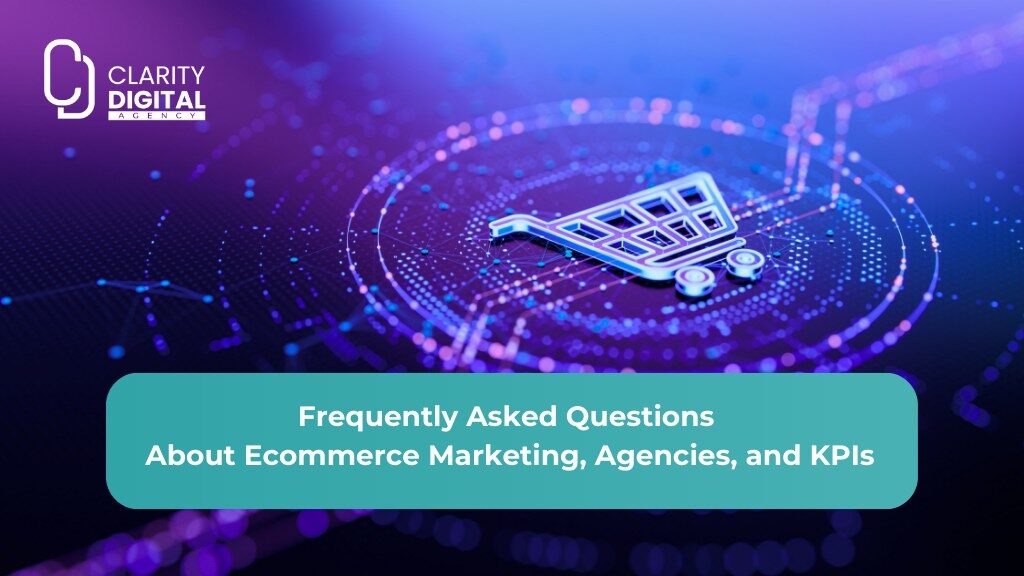
1. What is e-commerce digital marketing and why is it important?
E-commerce digital marketing refers to a suite of online strategies aimed at promoting products and driving traffic, engagement, and conversions for an online store. This includes SEO, paid advertising (PPC), email marketing, content marketing, social media, and more. It’s important because nearly every touchpoint in the buyer’s journey now occurs online—so without digital marketing, you’re virtually invisible to potential customers.
2. What’s the difference between e-commerce marketing and traditional digital marketing?
While digital marketing covers all types of online promotion, e-commerce marketing specifically focuses on strategies that lead to online transactions. This includes conversion-focused tactics like abandoned cart emails, dynamic product ads, and product feed optimization, which are not typically a focus for service-based digital marketing campaigns.
3. How does SEO work for e-commerce websites?
E-commerce SEO involves optimizing category pages, product pages, blogs, and even image content to improve rankings in search engines like Google. It includes technical SEO (site speed, schema), keyword research (transactional and informational intent), on-page optimization, and link building. For e-commerce, targeting keywords like “buy [product] online” or “best [product] for [use case]” is essential.
4. How long does it take for SEO to show results in e-commerce?
It typically takes 3 to 6 months to see meaningful results from e-commerce SEO efforts, depending on your competition, site authority, and technical health. For newer sites or competitive verticals (e.g., fashion, supplements), this timeline can extend to 9–12 months for top rankings.
5. What are the most effective e-commerce marketing channels today?
- Search (SEO + PPC) for intent-based buying
- Email for retention and loyalty
- Social media for discovery and brand building
- Retargeting ads for recapturing non-converting traffic
- Influencer and affiliate programs for scale and credibility
The best mix depends on your product, audience, and budget.
6. How does email marketing support an e-commerce strategy?
Email marketing boosts repeat purchases, upsells, and lifetime value. Campaigns like cart abandonment, win-back flows, product recommendations, and order follow-ups can increase conversion rates significantly. Email segmentation also allows for personalized offers, which improve engagement and ROI.
7. What KPIs should I track in e-commerce marketing?
- Conversion Rate (visitors to customers)
- Customer Acquisition Cost (CAC)
- Customer Lifetime Value (LTV)
- Return on Ad Spend (ROAS)
- Average Order Value (AOV)
- Cart Abandonment Rate
- Revenue per Visitor (RPV)
Tracking these consistently enables smarter budgeting and campaign optimization.
8. How can I reduce my customer acquisition cost (CAC)?
To lower CAC:
- Focus on organic channels like SEO and referrals
- Improve website conversion rates through A/B testing
- Use retargeting to convert warm traffic
- Optimize paid ads for Quality Score and CTR
- Build email and SMS lists to remarket without paying per click
9. What makes a great e-commerce landing page?
A high-converting landing page includes:
- A clear, benefit-oriented headline
- Product visuals or videos
- Social proof (reviews, ratings)
- Limited distractions (no unnecessary navigation)
- A compelling call-to-action (CTA)
- Fast loading time and mobile optimization
10. What platforms work best for e-commerce websites?
- Shopify: Easiest to use, great for DTC
- WooCommerce: Flexible, good for WordPress users
- BigCommerce: Ideal for growing brands
- Magento/Adobe Commerce: Enterprise-level features
The best platform depends on your budget, product catalog, and team’s technical capabilities.
11. What’s a good ROAS for e-commerce?
A 3:1 ROAS (i.e., $3 earned for every $1 spent) is considered healthy in most industries. But for high-margin products, a lower ROAS can still be profitable. Always compare ROAS to CAC and gross margins.
12. How do I know if my e-commerce marketing is working?
Beyond vanity metrics like impressions and likes, focus on:
- Increases in organic and paid traffic
- Lower CAC over time
- Growth in repeat purchase rate
- Positive ROAS
- Increase in customer LTV
Use Google Analytics 4, Meta Ads Manager, and e-commerce dashboards like Triple Whale or Lifetimely for tracking.
13. How is B2B e-commerce marketing different from B2C?
B2B focuses on:
- Longer sales cycles
- Higher purchase value
- Educational content
- Account-based marketing
- Platforms like LinkedIn and email nurturing
B2C focuses on:
- Emotional triggers
- Impulse buys
- Shorter funnels
- Social media engagement
- Flash sales and influencer marketing
14. What does an e-commerce marketing agency do?
An e-commerce agency manages all or part of your digital marketing: SEO, PPC, social ads, email marketing, influencer partnerships, and analytics. They act as an extension of your team—helping you scale faster without the overhead of hiring in-house.
15. What should I look for in an e-commerce marketing agency?
Look for:
- Industry experience
- Strong case studies and testimonials
- Transparent reporting and pricing
- Strategy-first approach (not just tactics)
- Collaborative communication style
Bonus: agencies that specialize in your platform (e.g., Shopify experts) often perform better.
16. When should I hire an e-commerce consultant vs. an agency?
Hire a consultant if:
- You need high-level strategy or audits
- You have internal execution bandwidth
- You want guidance before hiring full-time roles
Hire an agency if:
- You need execution across multiple channels
- You lack internal bandwidth
- You’re focused on scaling fast and need a team
Clarity Digital offers both models—consulting and full-service agency solutions.
17. How much should I budget for e-commerce marketing?
Early-stage brands typically invest 20–30% of revenue into marketing. Established brands may spend 10–15%. For paid acquisition (PPC, social ads), a minimum test budget of $3,000–$10,000/month is recommended to get meaningful data.
18. What are the biggest mistakes brands make in e-commerce marketing?
- Not understanding their audience
- Spreading budget too thin across too many channels
- Ignoring CRO (Conversion Rate Optimization)
- Over-relying on paid ads without building organic
- Not tracking performance or attribution accurately
19. How can I use influencers or creators to grow my e-commerce business?
Partner with micro or mid-tier creators who have authentic engagement.
Use UGC (user-generated content) for ads and product pages.
Track ROI with affiliate links or discount codes.
Use influencer whitelisting for extended ad reach.
20. Why is Clarity Digital Agency trusted by e-commerce brands?
Clarity Digital Agency combines strategy, execution, and transparency. With deep experience across SEO, paid media, lifecycle marketing, and CRO, we act as a strategic partner—not just a vendor. We’ve helped DTC brands, B2B marketplaces, and hybrid e-commerce players grow profitably with measurable results.
21. Where should I incorporate AI in my e-commerce marketing strategy?
AI can enhance nearly every stage of the customer journey. Use AI to:
- Personalize product recommendations (e.g., Amazon-style suggestions)
- Automate email and SMS flows based on behavior and engagement
- Predict customer lifetime value (LTV) and churn risk
- Optimize paid ad targeting with lookalike modeling and predictive bidding
- Create dynamic pricing strategies that respond to real-time demand
- Generate SEO-optimized content and product descriptions at scale
AI lets you scale personalization, automation, and decision-making in ways manual processes can’t match.
22. What AI tools are useful for e-commerce marketing?
Here are top-performing tools by category:
- Content Generation: Jasper, Copy.ai, ChatGPT
- Email/SMS Automation: Klaviyo AI, Drip, Postscript
- Ad Optimization: Smartly.io, Meta’s Advantage+ campaigns, Google Performance Max
- Customer Analytics: Pecan.ai, Glew.io, Lifetimely
- Visual Search & Product Discovery: Syte, Vue.ai
- Chatbots & Support: Tidio, Gorgias AI Assist, Zendesk AI
Select tools that integrate well with your tech stack and align with your marketing objectives.
23. Can AI improve my e-commerce SEO and content strategy?
Yes—AI can help you scale content creation and keyword research. Use AI tools to:
- Generate product descriptions, FAQs, and meta tags
- Identify keyword gaps and cluster content thematically
- Optimize existing content for readability and engagement
- Create blog content tailored to search intent
However, AI should complement—not replace—human oversight. Always review for accuracy, brand tone, and originality to avoid SEO penalties.
24. Is AI-powered personalization better than manual segmentation?
In most cases, yes. AI-powered personalization reacts in real time to user behavior, optimizing recommendations, emails, and offers automatically. This leads to:
- Higher conversion rates
- Better retention
- Improved customer satisfaction
Platforms like Klaviyo, Salesforce Commerce Cloud, and Shopify’s Shop App use AI to deliver 1:1 personalized experiences far beyond rule-based segmentation.
25. How can AI automation improve email marketing for e-commerce?
AI-powered email marketing helps e-commerce brands move from batch-and-blast campaigns to hyper-personalized, behavior-driven experiences—at scale. Here’s how:
1. Predictive Segmentation
AI tools analyze customer data to identify patterns and automatically segment users based on likelihood to purchase, churn risk, average order value, etc. For example:
- High-LTV customers receive early access to product drops
- At-risk customers get win-back incentives or feedback surveys
2. Smart Send Time Optimization
AI determines the optimal time for each subscriber to receive emails based on past engagement. This boosts open rates and CTRs without additional manual work.
3. Content Personalization at Scale
Tools like Klaviyo’s Smart Product Feeds or Salesforce Marketing Cloud use AI to:
- Recommend products based on browsing or purchase history
- Insert dynamic content blocks (e.g., location-based promos or gender-specific images)
- Adjust subject lines and CTAs based on engagement data
4. Automated A/B Testing
AI can run multivariate tests across subject lines, images, copy, and CTAs—and automatically promote winning variants, ensuring you’re always optimizing without manually monitoring campaigns.
5. Lifecycle Automation Flows
From welcome emails to post-purchase review requests, AI helps trigger the right message at the right time based on user behavior. Common flows include:
- Abandoned cart emails (using dynamic pricing or urgency)
- Product replenishment reminders
- Loyalty milestone recognition
- VIP upsell flows
6. Predictive Analytics & Campaign Insights
AI helps forecast revenue per campaign, monitor deliverability, and suggest improvements. Tools like RetentionX and Zaius even recommend next-best actions based on customer journey mapping.
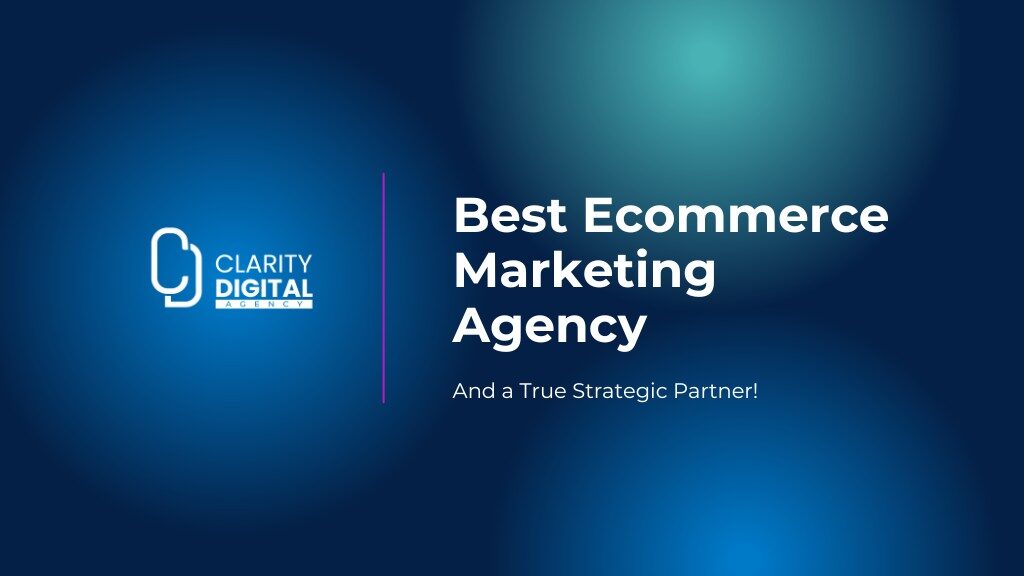
Clarity Digital Agency: Best Ecommerce Marketing Agency
A True Ecommerce Agency Partner
What sets Clarity Digital apart isn’t just our deep technical knowledge—it’s how we connect strategy with execution. We don’t just run ads or publish blogs. We ask hard questions. We audit your funnel. We listen to your goals, test hypotheses, and obsess over performance data.
Our core strengths include:
- Omnichannel strategies tailored to your growth stage
- Deep experience with Shopify, WooCommerce, Magento, and headless builds
- Transparent reporting and KPI tracking (from ROAS to LTV:CAC ratios)
- A hands-on, collaborative approach—we act like an extension of your team
If you’re looking for an e-commerce partner that treats your budget like it’s our own and drives results that actually impact your bottom line—we’re here to help.

